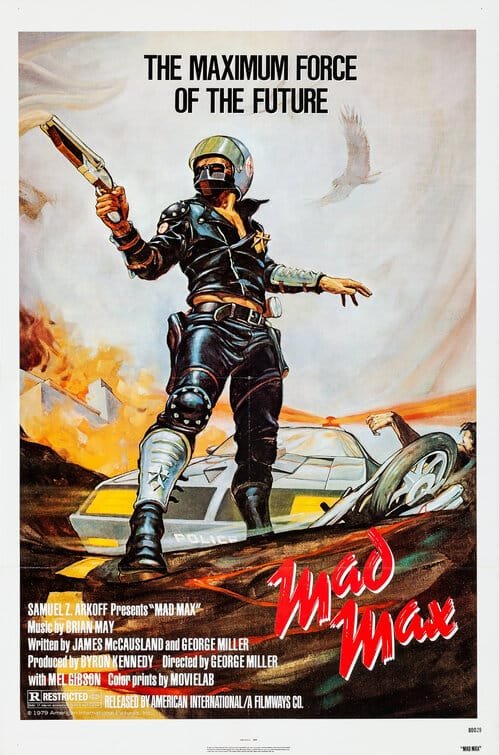In a not-too-distant dystopian future, when man’s most precious resource – oil – has been depleted and the world plunged into war, famine and financial chaos, the last vestiges of the law in Australia attempt to restrain a vicious biker gang. Max (Gibson), an officer with the Main Force Patrol, launches a personal vendetta against the gang when his wife (Samuel) and son are hunted down and murdered, leaving him with nothing but the instincts for survival and retribution.
With 4 films in the series (and a spin-off) by this point, it seemed time to go back and check out the original, Mad Max. With Mel Gibson’s voice (and the rest of the actors) originally dubbed for the American version (with American International Pictures fearing Americans wouldn’t understand the Australian accents), it seemed like a curious one anyway (thankfully, on streaming, they have the un-dubbed version). This is especially for an actor who would become so well-known thanks to this movie. But, would it be any good now, this film shot on a shoestring budget back in the 70’s? Or has time’s rough road claimed another victim?
Mel Gibson takes the lead in Mad Max as the title character, and viewers can see the beginnings of his rise to stardom in the role. He undergoes happiness, rage and grief in the pic, and makes it all seem believable, despite the post-apocalyptic world around him. He’s pretty good, but not quite up the level of his Lethal Weapon, Braveheart or Ransom performances. His chemistry with “wife” Joanne Samuel seems genuine too.
The rest of the cast is decent enough. Hugh Keays-Byrne (who would later go on to play the bad guy in future sequel Mad Max: Fury Road) is decently evil as villain Toecutter, and provides a decent – if simple – portrayal of a bad gang leader. Tim Burns, playing new gang recruit Johnny the Boy, is pretty good as well, and he actually pops up more than his boss in the film. And Steve Bisley, playing Goose, dang near steals the show from Gibson during his sequences, even though he doesn’t get nearly as much of the spotlight.
George Miller, who wrote and directed the film, obviously had a clear vision in his head of how the story was going to go in Mad Max. While the budget (a mere $350,000) may not have let him fully realize his vision this time around, he still put together a pretty decent script. Max’s entrance – with the viewer only getting glimpses of him during a car chase before he’s finally let loose and fully revealed – quickly lets the viewer know he’s going to be the guy to watch, and that he’s a tough-as-nails cop who isn’t afraid to get violent.
From that beginning, the film does seem to meander for a bit, and takes way too long to get to the meat of the story. While most viewers nowadays will easily guess what all the mucking about is finally going to lead to, at the time it probably seemed pretty shocking. Alas, with so many flicks with a similar theme these days (albeit one set during the current time, not the future), viewers won’t really see much that feels fresh to them. Still, Miller’s directing in this first film – especially when the gang attacks a car – has a raw edge to it that hearkens back a bit to the visual style used in classic horror film The Texas Chain Saw Massacre.
Most films shot on extremely low budgets tend to stay small, proving you don’t need to go all out to deliver a solid film. Unfortunately, Mad Max’s premise of a struggling police force doing its best to keep law and order in a very nearly lawless time is not a small idea, and it just points out the obvious lack of budget. Chase sequences had to be cut because they were too expensive to shoot, and the “post-apocalyptic” wasteland just looks the desert on the edge of a small town, with the viewer finding out it’s set after an apocalypse thanks more to the plot synopsis than anything really showcased (or talked about) in the film. It’s a grandiose vision that the small budget couldn’t handle, and viewers will find it a bit lacking.
While Mad Max isn’t really a great film, it does showcase the talents of both beginning writer/director George Miller and a young Mel Gibson. While Miller would keep building on this throughout his directing career (with Mad Max: Fury Road probably his crowning achievement), Gibson would go on to prove he could not only outdo himself in a post-apocalyptic road movie (The Road Warrior) but become a huge action star (Lethal Weapon and its sequels) – not bad for a writer/director and main star who got their starts on this low budget classic.
















